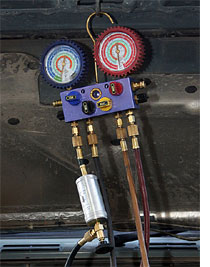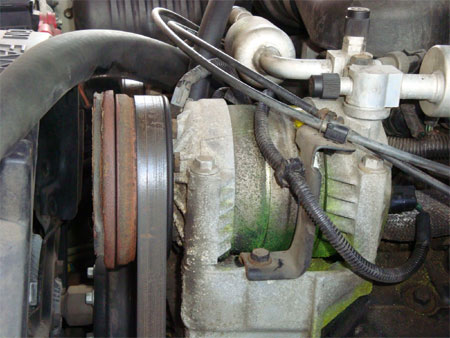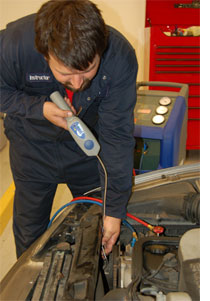Does your car's aircon leak?
When servicing automotive air-conditioning systems, vehicle owners generally have several options to recharge a/c systems with refrigerant. One option is to top-off your car's system with refrigerant, and another is to evacuate and recharge the system.
Both of these options will provide cool air in the passenger compartment for some period of time. Neither service, however, involves permanently fixing the a/c system leaks that allowed refrigerant to escape resulting in a lack of cool air. You might therefore also choose to have any leaking components in your a/c system repaired or replaced.
By stopping the leak, you will prevent refrigerant from leaking into the atmosphere. The refrigerant in older vehicles is CFC-12 (also known as Freon, a brand name), which is no longer manufactured in the United States because it depletes the ozone layer. As nationwide supplies dwindle, it is becoming increasingly expensive to purchase CFC-12, so that fixing a leak may be more economical in the long run than continuing to purchase CFC-12.
A top-off involves simply charging refrigerant into your vehicle. An evacuation and recharge service includes removing whatever remaining refrigerant is in your vehicle, removing impurities from that refrigerant using recycling equipment, recharging it into the vehicle, and adding new refrigerant to replace whatever has leaked out. The cost of both the top-off and the evacuation and recharge will usually include a performance check, and may include a test to discover the source of your leak.
Topping-off alone is less expensive than the evacuation and recharge service. So why would you consider the more expensive evacuation and recharge? The manufacturer of your vehicle has determined that a specific amount of refrigerant -- 2.2 pounds, for example -- is correct for your car. When you bring your vehicle into a service facility, your technician has no way of determining precisely how much refrigerant is left in your vehicle's system. As he tops off the system, then, he relies on his experience to guess how much refrigerant to charge into the system; however, he may undercharge or overcharge the system, thereby affecting system performance. Most recent models have a feature that shuts an overcharged a/c system down in hot weather.
On the other hand, during an evacuation and recharge, once the technician has extracted all remaining refrigerant from the system, he will then be able to charge the system with the precise amount of refrigerant recommended by the vehicle's manufacturer.
Some technicians may tell you that evacuation and recharge is better for the system than a mere top-off because, after the refrigerant is evacuated, it gets cleaned in the recycling equipment, and it's a good idea to clean the refrigerant in your system. There is, in fact, no reason to clean the refrigerant in your system unless you open up the system. If you request that your technician repair or replace system components in order to fix leaks in your system, then he will need to open the system and should recycle the refrigerant.
In order to find the source of a leak, the technician will need to add refrigerant to the system if only a small amount of refrigerant remains, and the refrigerant is at a pressure of less than 50 pounds per square inch. However, if there are at least a few ounces of refrigerant already in the system, a technician should not need to add refrigerant in order to identify which components will require replacement. (Keep in mind that a greater quantity of refrigerant -- usually a minimum of 1-1.5 pounds -- must be in the system in order to determine if the system will provide cooling.)
Once the technician has provided his diagnosis and estimate of repair costs to the customer, the customer may decide not to have the repairs performed. The technician should then either remove all the refrigerant that was installed in order to perform the diagnosis, or, if the customer prefers, the technician can top-off the system.
Technicians may occasionally tell their customers that any refrigerant that was in the vehicle when it came into the shop cannot be returned to the customer due to federal regulations. No such federal regulation exists, however.
Even though you are entitled to the refrigerant that was in your vehicle when you brought it in, you should keep in mind that technicians are unable to determine precisely how much refrigerant they have removed from a/c systems -- their recovery equipment does not indicate the amount extracted. So if your technician attempts to remove any refrigerant he added to your system in order to perform a diagnosis, he can only rely on his experience to make an educated guess as to when to turn off his recovery equipment.
Leaks can be identified most, but not all, of the time. Your technician may have difficulty locating very small leaks in your a/c system, even if he is very careful and uses the most sophisticated equipment available.
Keep in mind that even when pinhole leaks cause slow emissions over long periods of time, your system may seem to lose its cooling capacity suddenly. This is because most motor vehicle a/c systems have controls that shut off a system when the system pressure drops below a certain point.




